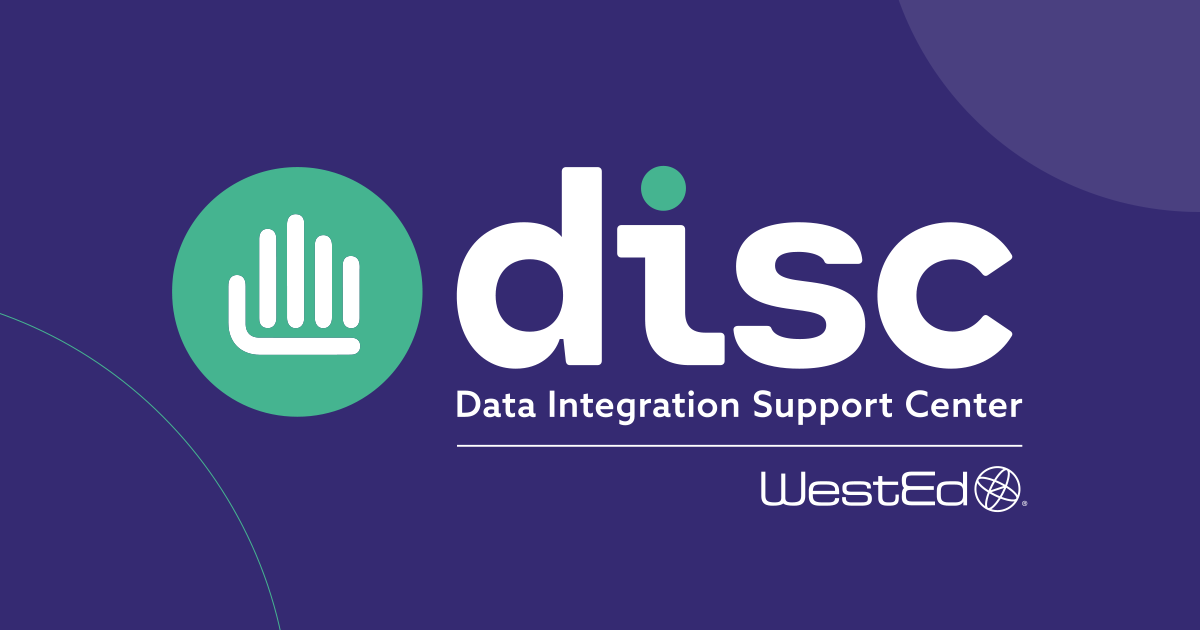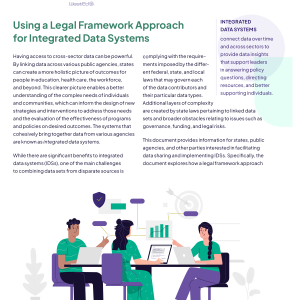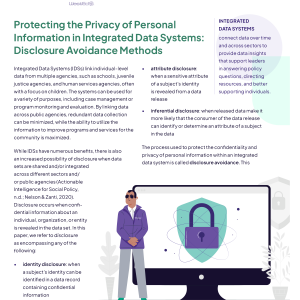Building and Modernizing Integrated Data Systems to Support the Whole Person
Posted on

Integrated data systems connect data over time and across sectors to provide data insights that support leaders in answering policy questions, directing resources, and better supporting individuals. The integration of data from education, workforce, social services, and other sectors is critical for designing effective policies that support the whole child, the whole person, and the whole community. State rules, privacy concerns, and knowledge of social service and labor laws can make data integration difficult.
WestEd’s Data Integration Support Center (DISC) helps public agencies address these challenges while supporting data integration efforts. In this first of a five-part Q&A series, the DISC team talks about data integration and the mission behind their work.
How was the Data Integration Support Center started and what does it seek to accomplish?
Baron Rodriguez, DISC’s Executive Director, previously led the Privacy and Technical Assistance Center (PTAC) within the U.S. Department of Education’s Student Privacy Policy Office. Baron also previously worked on the State Longitudinal Data System (SLDS) State Support Team with Sean Cottrell, DISC’s Operations Director. Their experiences highlighted the gaps in available resources for public agencies that are building and modernizing their integrated data systems.
Why is data integration so important for public agencies and other organizations?
Often, the data available from a single agency cannot provide the sorts of information needed to inform pathways, transitions, and policies. Merging data across a variety of sources provides more meaningful and contextual information, so that decision-makers at all levels have actionable information. This aids in informed decision-making; resource optimization; and improved citizen services.
What challenges exist when trying to integrate data from different sources and how does DISC help?
Many people assume the biggest challenge is in developing the data system itself. But major advances in technology allow systems to be built securely in ways that protect the privacy of the individuals represented in the system. The biggest challenge is engaging people across the state to understand the value of integrated data in supporting the state’s priorities and then acting to establish the legal framework to achieve the goals of the state.
What is DISC’s approach to data integration?
Our approach involves considering the entire data lifecycle, from collection to analysis and destruction. It includes integrating data from diverse sources; ensuring data quality; and aligning with business goals. We incorporate technology, processes, and people to create a unified and coherent data environment for better decision-making.
How do you serve as a thought partner with public agencies and other organizations?
Our primary approach is to ensure experiences and ideas are shared, so that others may easily navigate through difficult challenges. We do this in the following ways:
- Supporting data—We support integrations across sectors that provide that provide a whole-person, whole-community picture, enabling more equitable outcomes.
- Expanding capacity—We accelerate data integration efforts through legal assistance and research, privacy and security expertise, and governance facilitation.
- Ensuring actionability—We support implementation of user-centered design and engage community members, ensuring transparency about which data is linked and how it can be accessed and used.
- Monitoring legislative and regulatory developments—We review and analyze federal, state, and local laws that impact data integration efforts.
- Empowering public agencies—We support modernizing and aligning federal privacy laws and guidance across sectors. This allows decision-makers and leaders the independence to choose data integration paths that include social services, the workforce, and early childhood aligned to state needs.
How do you address incomplete and inequitable data?
Addressing incomplete and inequitable data involves a multifaceted approach to enhance data quality and fairness. It includes identifying and acknowledging gaps; engaging stakeholders; implementing inclusive collection and design practices; utilizing multiple data sources; conducting regular data audits; identifying and addressing bias and fairness; educating data collectors; establishing community involvement in governance; being transparent in communication; striving for continuous improvement; and having legal and ethical compliance.
The biggest challenge is engaging people across the state to understand the value of integrated data in supporting the state’s priorities and then acting to establish the legal framework to achieve the goals of the state.
On the surface, a solution would be for all the states to be on the same data system. But you say a one-size-fits all solution doesn’t exist.
While a unified, nationwide, integrated data-system solution might seem like an ideal solution for efficiency and consistency, the reality is that a one-size-fits-all approach faces many challenges:
- Diverse needs and priorities—States and regions often have unique needs, priorities, and demographic profiles. A standardized system may not cater effectively to the specific requirements for each state.
- Legal and regulatory variances—Each state operates under its own set of laws and regulations. Legal and regulatory differences can impact data collection, storage, and usage, making a uniform system challenging.
- Cultural and social variability—States have diverse cultural and social contexts that influence data requirements. What works well in one region may not be suitable or acceptable in another due to cultural differences.
- Governance and decision-making differences—States have different governance structures and decision-making processes. Implementing a centralized system would require overcoming significant political and administrative challenges.
- Technological structure variances—States have different levels of technological readiness. Implementing a uniform system would require significant investment in standardizing and upgrading existing infrastructure.
- Data security and privacy concerns—Standardizing data systems raises concerns about centralized data security and privacy. Different states may have varying levels of comfort with centralized data storage and management.
- Resistance to change—Implementing a one-size-fits-all solution may face resistance from states accustomed to their existing systems. Change-management challenges could also hamper successful adoption.
- Flexibility for innovation—A rigid, standardized system may stifle innovation at the state level. States may want the flexibility to adopt emerging technologies and tailor solutions to their specific needs.
- Resource allocation challenges—States have different budgetary constraints and resource availability. Implementing and maintaining a uniform system may strain the resources of certain states.
- Political consideration—Political dynamics play a significant role in decision-making at the state level. A centralized approach may face political resistance, affecting its feasibility.
While collaboration and data interoperability between states are crucial, a more realistic approach involves establishing common standards, protocols, and frameworks that allow for interoperability while accommodating regional variations. This approach enables states to share essential information without compromising their ability to address unique challenges and meet specific needs.
Tell us about some of your current projects.
Many state data-integration efforts have a desire for more meaningful and nuanced information on resident pathways through the education and economic systems in the state. There are many opportunities to include additional data linkages that provide information on federal employees and military service, more nuanced wage information, and the impact of public health on those pathways.
At DISC, we are working with several state data-integration efforts and hear consistent messages around quality of data; restrictions of social security number linkages; as well as gaps in linkages due to a variety of factors.
During the National Center for Education Statistics’ annual STATS-DC Conference, experts from DISC, along with state presenters from Nebraska and California, presented resources and approaches aimed at demystifying the workforce landscape in an effort to remove barriers to more meaningful data.
Visit the DISC website to learn more.
Join us on Facebook and LinkedIn to learn more about and discuss data integration.


